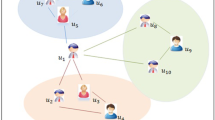Abstract
With the recent tremendous increase in the volume of Web 3.0 content, content recommendation systems (CRS) have emerged as an important aspect of social network services and computing. Thus, several studies have been conducted to investigate content recommendation methods (CRM) for CRSs. However, traditional CRMs are limited in that they cannot be used in the Web 3.0 environment. In this paper, we propose a novel way to recommend high-quality web content using degree of centrality and term frequency–inverse document frequency (TF–IDF). In the proposed method, we analyze the TF–IDF and degree of centrality of collected RDF site summary and friend-of-a-friend data and then generate content recommendations based on these two analyzed values. Results from the implementation of the proposed system indicate that it provides more appropriate and reliable contents than traditional CRSs. The proposed system also reflects the importance of the role of content creators.







Similar content being viewed by others
References
Barabasi, A. L., Jeong, H., Neda, Z., et al. (2002). Evolution of the social network of scientific collaborations. Physica A-Statistical Mechanics and Its Applications, 311(3–4), 590–614.
Kumar, R., Raghavan, P., Rajagopalan, S., et al. (2002). The Web and social networks. Computer, 35(11), 32.
Aikebaier, A., Enokido, T., & Takizawa, M. (2011). Trustworthy group making algorithm in distributed systems. Human-Centric Computing and Information Sciences, 1(1), 6.
Pazzani, M., & Billsus, D. (2007). Content-based recommendation systems. The adaptive web, pp. 325–341.
Yang, W. S., Cheng, H. C., & Dia, J. B. (2008). A location-aware recommender system for mobile shopping environments. Expert Systems with Applications, 34(1), 437–445.
Goldberg, D., Nichols, D., Oki, B. M., et al. (1992). Using collaborative filtering to weave an information tapestry. Communications of the ACM, 35(12), 61–70.
Konstan, J. A., Miller, B. N., Maltz, D., et al. (1997). GroupLens: Applying collaborative filtering to Usenet news. Communications of the ACM, 40(3), 77–87.
Albadvi, A., & Shahbazi, M. (2009). A hybrid recommendation technique based on product category attributes. Expert Systems with Applications, 36(9), 11480–11488.
Ghazanfar, M. A. & Prugel-Bennett, A. (2010). A scalable, accurate hybrid recommender system. In proceedings of WKDD ’10, pp. 94–98.
Goksedef, M., & Gunduz-Oguducu, S. (2010). Combination of Web page recommender systems. Expert Systems with Applications, 37(4), 2911–2922.
Montaner, M., Lopez, B., & de la Rosa, J. L. (2003). A taxonomy of recommender agents on the Internet. Artificial Intelligence Review, 19(4), 285–330.
Zanker, M., & Jessenitschnig, M. (2009). Collaborative feature-combination recommender exploiting explicit and implicit user feedback. In Proceedings of commerce and enterprise computing, pp. 49–56.
FOAF project. http://www.foaf-project.org.
Gruhl, D., Meredith, D. N., Pieper, J. H., Cozzi, A., & Dill, S. (2006). The web beyond popularity: A really simple system for web scale RSS. In Proceedings of the 15th international conference on, World Wide Web, pp. 183–192.
Salton, G., & Buckley, C. (1988). Term-weighting approaches in automatic text retrieval. Information Processing & Management, 24(5), 513–523.
Scott, J. (1988). Social network analysis. Sociology, 22(1), 109–127.
Lawton, G. (2001). Knowledge management: Ready for prime time? Computer, 34(2), 12–14.
Schafer, J. B., Frankowski, D., Herlocker, J., & Sen, S. (2007). Collaborative filtering recommender systems. The adaptive web, pp. 291–324.
Suchal, J., & Návrat, P. (2010). Full text search engine as scalable k-nearest neighbor recommendation system. Artificial Intelligence in Theory and Practice, III, 165–173.
Wang, T. I., Wang, K. T., & Huang, Y. M. (2008). Using a style-based ant colony system for adaptive learning. Expert Systems with Applications, 34(4), 2449–2464.
Yang, Y. J., & Wu, C. I. (2009). An attribute-based ant colony system for adaptive learning object recommendation. Expert Systems with Applications, 36(2), 3034–3047.
Elmisery, A. M., & Botvich, D. (2011). Enhanced middleware for collaborative privacy in IPTV recommender services. Journal of Convergence, 2(2), 33–42.
Pan, R., Xu, G., Fu, B., et al. (2012). Improving recommendations by the clustering of tag neighbours. Journal of Convergence, 3(1), 13–20.
Burke, R. (2002). Hybrid recommender systems: Survey and experiments. User Modeling and User-Adapted Interaction, 12(4), 331–370.
Koren, Y., Bell, R., & Volinsky, C. (2009). Matrix factorization techniques for recommender systems. Computer, 42(8), 30–37.
Shtykh, R. Y., & Jin, Q. (2011). A human-centric integrated approach to web information search and sharing. Human-Centric Computing and Information Sciences, 1(1), 1–37.
Facebook. http://www.facebook.com.
Livejournal. http://livejournal.com.
Twitter. http://www.twitter.com.
Author information
Authors and Affiliations
Corresponding author
Rights and permissions
About this article
Cite this article
Sohn, JS., Bae, UB. & Chung, IJ. Contents Recommendation Method Using Social Network Analysis. Wireless Pers Commun 73, 1529–1546 (2013). https://doi.org/10.1007/s11277-013-1264-z
Published:
Issue Date:
DOI: https://doi.org/10.1007/s11277-013-1264-z




